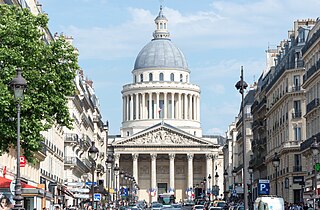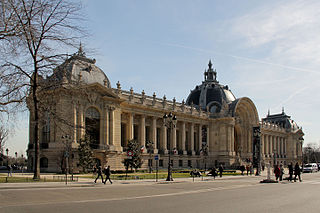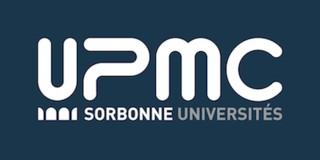
The Latin Quarter of Paris is an area in the 5th and the 6th arrondissements of Paris. It is situated on the left bank of the Seine, around the Sorbonne.

The 5th arrondissement of Paris is one of the 20 arrondissements of the capital city of France. In spoken French, this arrondissement is referred to as le cinquième.

Sorbonne University is a public research university in Paris, France, established in 2018 by the merger of Paris-Sorbonne University and Pierre et Marie Curie University, along with smaller institutions. The university's current legal status was introduced in 2018 but the legacy of the institution reaches back to 1257 when Sorbonne College was established by Robert de Sorbon as part of the medieval University of Paris. It is one of the most prestigious universities in Europe and the world; as of 2021, Sorbonne University's alumni and professors have won 33 Nobel Prizes, 6 Fields Medals and one Turing Award.

The Jardin des plantes, also known as the Jardin des plantes de Paris when distinguished from other jardins des plantes in other cities, is the main botanical garden in France. The term Jardin des plantes is the official name in the present day, but it is in fact an elliptical form of Jardin royal des plantes médicinales, which is related to the original purpose of the garden back in the 17th century.

Paris Diderot University, also known as Paris 7, was a French university located in Paris, France. It was one of the seven universities of the Paris public higher education academy. The university became a member of the Sorbonne Paris University Group on March 31, 2010. It merged with the Paris Descartes University in 2019, gaining its new appellation, the University of Paris.

The Petit Palais is an art museum in the 8th arrondissement of Paris, France.

Paris-Sorbonne University was a public research university in Paris, France, active from 1971 to 2017. It was the main inheritor of the Faculty of Humanities of the University of Paris. In 2018, it merged with Pierre and Marie Curie University and some smaller entities to form a new university called Sorbonne University.

Pierre and Marie Curie University, also known as Paris 6, was a public research university in Paris, France, from 1971 to 2017. The university was located on the Jussieu Campus in the Latin Quarter of the 5th arrondissement of Paris, France. UPMC merged with Paris-Sorbonne University into a new combined Sorbonne University.

The Institut du Monde Arabe, French for Arab World Institute, abbreviated IMA, is an organization founded in Paris in 1980 by France with 18 Arab countries to research and disseminate information about the Arab world and its cultural and spiritual values. The Institute was established as a result of a perceived lack of representation for the Arab world in France, and seeks to provide a secular location for the promotion of Arab civilization, art, knowledge, and aesthetics. Housed within the institution are a museum, library, auditorium, restaurant, offices and meeting rooms.

Sorbonne Paris North University is one of the universities that succeeded the Sorbonne after the breakup of the University of Paris into thirteen autonomous universities in 1968, it is a multidisciplinary university located north of Paris, in the municipalities from Villetaneuse, Saint-Denis, La Plaine Saint-Denis, Bobigny and d'Argenteuil.

The Château de Janvry is a stately home in the French village of Janvry, Essonne. It is in the Île-de-France region, 27 km south west of Paris.

The Château de Richelieu was an enormous 17th-century château built by the French clergyman, nobleman, and statesman Cardinal Richelieu (1585–1642) in Touraine. It was demolished for building materials in 1805 and almost nothing of it remains today. It lay south of Chinon and west of Sainte-Maure de Touraine, just south of what is now Richelieu, Indre-et-Loire, surrounded by mostly agricultural land.

The Hôtel de Beauvais is a hôtel particulier, a kind of large townhouse of France, at 68 rue Francois-Miron, 4th arrondissement, Paris. Until 1865 rue Francois-Miron formed part of the historic rue Saint Antoine and as such was part of the ceremonial route into Paris from the east. The hotel was built by the royal architect Antoine Le Pautre for Catherine Beauvais in 1657. It is an example of eclectic French baroque architecture.
The Grands Projets of François Mitterrand was an architectural programme to provide modern monuments in Paris, the city of monuments, symbolising France's role in art, politics and the economy at the end of the 20th century. The programme was initiated by François Mitterrand, the 21st President of France, while he was in office. Mitterrand viewed the civic building projects, estimated at the time to cost the Government of France 15.7 billion French francs, both as a revitalisation of the city, as well as contemporary architecture promoted by Socialist Party politics. The scale of the project and its ambitious nature was compared to the major building schemes of Louis XIV.

Sorbonne University Association is a group of 10 academic institutions associated with the Sorbonne University. After the fusion between Paris-Sorbonne University and Pierre and Marie Curie University under the name Sorbonne University in 2018, the group Sorbonne Universités changed its name to Association Sorbonne Université.

The Bibliothèque interuniversitaire de la Sorbonne is an inter-university library in Paris, France. It is situated in the Sorbonne building. It is a medieval institution of the Sorbonne, which evolved over the centuries as part of the University of Paris. It is a common library of Panthéon-Sorbonne University and Sorbonne-Nouvelle University. It is administered by Panthéon-Sorbonne University as per a governing agreement signed among these universities in 2020.

The Château du duc d'Épernon is a château, built on the site of a medieval castle located in Fontenay-Trésigny, in the Brie region of France, 43 km (27 mi) southeast of Paris. It stands alongside the Bréon stream and next to the Church of Saint-Martin, in the heart of a once walled old town, the history of which is closely linked to the history of the château. The castellans were lords of Fontenay-en-Brie during the Old Regime.
The Cour Carrée is one of the main courtyards of the Louvre Palace in Paris. The wings surrounding it were built gradually, as the walls of the medieval Louvre were progressively demolished in favour of a Renaissance palace.

The Hôtel Hesselin, later known as the Hôtel d'Ambrun, was a Parisian town house, erected around 1639 to 1642 for Louis Hesselin to the designs of the French architect Louis Le Vau. It was located on the Île Saint-Louis, on the west side of the rue Poulletier at its intersection with the quai du Dauphin. The hotel was demolished in 1935 by Helena Rubinstein, who had a new building erected to the designs of the architect Louis Sue.

Beauregard Castle is a ruined castle on the territory of Chippis in the canton of Valais, Switzerland. It is situated on a rocky spur at the entrance to the Val d'Anniviers.



















